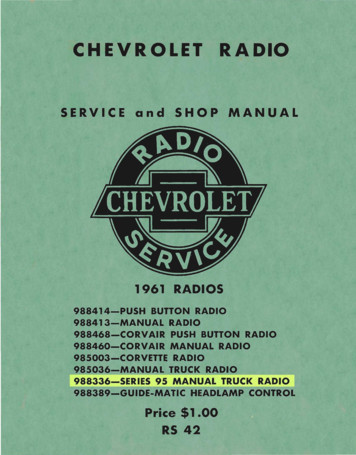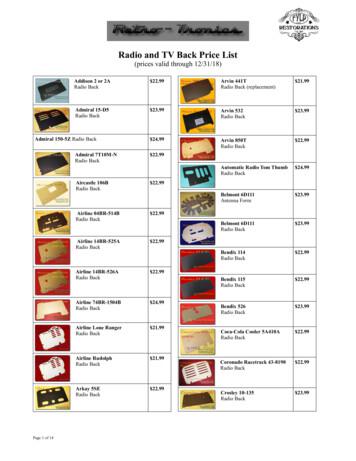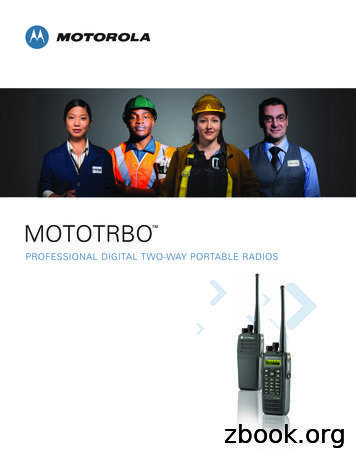Introduction To Digital Mobile Radio (DMR)
Introduction toDigital Mobile Radio (DMR)By John S. Burningham, W2XABw2xab@arrl.netMay 2015
The Amateur DMR NetworksOver 1,275 registered repeaters. Over 14,738 registered radios. The Networks are divided byinfrastructure Mototrbo (Motorola Solutions) Most common around the world, about 95%. Hytera
Major Mototrbo Networks Wide Area Networks DMR-MARC (Motorola Amateur Radio Club) Radio registration Network Pin Maps http://www.dmr-marc.org DCI (Digital Communications Interconnect) http://www.trbo.org DMR-NA (DMR Core Talkgroup Server Project) http://www.dmr-na.com Regional Groups Typically associated with one or more of the wide area networkswhich supply Talk Group interconnections.
The Bridged Network ExampleDMR-MARC CC1DMR-MARC CC2NATS-PNATS-SDCIAccess BridgeAccess BridgeAccess BridgeRPT3RPT2RPT1RPT6RPT4RPT5
What is DMR?Digital Mobile Radio (DMR) wasdeveloped by the EuropeanTelecommunications Standards Institute(ETSI) and is used worldwide byprofessional mobile radio users. DMR is divided into three tiers. Tier I Tier II Tier III
Tier I Tier I is a single channel specificationoriginally for the European unlicenseddPMR446 service. It is a single channelFDMA 6.25 kHz bandwidth; the standardsupports peer-to-peer (mode 1), repeater(mode 2) and linked repeater (mode 3)configurations. The use of the Tier Istandard has been expanded into radiosfor use in other than the unlicenseddPMR446 service.
Tier II (The Standard for Amateur Networks) Tier II is 2-slot TDMA 12.5 kHz peer-topeer and repeater mode specification,resulting in a spectrum efficiency of 6.25 kHzper channel. Each time slot can be eithervoice and/or data depending upon systemneeds.IP Site Connect (IPSC) for interconnectingrepeaters over the Internet is vendorspecific and not part of the ETSI standards atthis time. Most amateur radioimplementations of DMR are using voice onboth time slots.
Tier III Tier III builds upon Tier II, adding trunkingoperation involving multiple repeaters at asingle site. Not all manufacturers’ trunkingimplementation is Tier III compatible.Vender specific protocols have expandedthe trunking to multiple site operations.
Vocoder The current implementation of DMRutilizes the DSVI AMBE 2 vocoder byagreement of the manufactures; it is notspecified in the ESTI standard. Most of theradio manufacturers have implementedthe vocoder in licensed software. Theforward error correction in theAMBR 2 this is an improvement of thevoice quality of older vocoders such asused by D-Star .
DMR 2-Slot TDMADMR Tier II/Tier III occupies a 12.5 kHzbandwidth with two channels sharing usingTime-Division Multiple Access (TDMA), thisresults in spectrum efficiency of 6.25 kHz perchannel. Comparing the spectrum efficiency of DMR to awideband analog FM, DMR only uses 25% of thebandwidth per talk channel. Each channel can carry either voice and/or datadepending on system design. The two time slots are called Time Slot 1 (TS1)and Time Slot 2 (TS2).
DMR 2-Slot TDMA For the amateur, this means one repeater allows twoseparate channels at the same time.Currently most amateur DMR repeater systemimplementations utilize both channels for voice andsome limited text messaging.Typically one channel (time slot) is used for wide-areaand the second is local and regional talk groups.For repeater operators, a single two-slot TDMArepeater offers a significant savings over two standalonerepeaters to obtain two separate communicationchannels as only one repeater, one duplexer, and oneantenna system is required.
DMR 2-Slot TDMA The two-slot TDMA implemented in DMR uplinks(portable/mobile to repeater) uses a 30-ms window foreach time slot, the 30-ms is further divided into a 27.5ms frame and a 2.5-ms gap. This means whentransmitting, your transmitter is only turned on for27.5ms every 60ms resulting is extended battery life forportables.The DMR repeater (downlink) transmits a continuousdata stream even if only one timeslot is being used; the2.5-ms uplink gap is replaced with a CACH burst(Common Announcement Channel) that is used forchannel management and low speed signaling.
The Frame The 27.5-ms frame consists of a total of264-bits; 108-bit payload, 48-bit SYNC orembedded signaling, and a second 108-bitpayload for a total of 216-bits of payload perframe.The vocoder must compress 60-ms of audiowith FEC (forward error correction) into216-bits of data for transmission.The 2.5ms-gap is used for guard time toallow PA ramping and propagation delay.
DMR TerminologyTalk Groups Zones Color Codes Code Plugs Scanning Roaming Simplex Admit Criteria
Talk Groups (TG)Talk Groups (TG) are a way for groups of usersto share a time slot (one-to-many) withoutdistracting and disrupting other users of thetime slot. It should be noted that only one talk group canbe using a time slot at a time. If your radio is not programmed to listen to atalk group, you will not hear that talk group’straffic.
Zones User DMR radios support Zones, a Zoneis just a grouping of individual channels.Some model radios may limit the numberof channels per Zone and the number ofZones allowed.
Color Codes (CC) DMR repeaters use Color Codes (CC) much likeanalog repeaters use CTCSS or DCS.To access a repeater you must program your radio touse the same CC as the repeater.There are 16 different CCs (CC0-CC15). The factorydefault is CC1.The use of Color Codes is not optional on DMRsystems.If your Color Code is not set correctly, you will not beable to access the repeater.The only real purpose of using different Color Codes iswhen multiple repeaters operating on the samefrequency have overlapping coverage areas.
Code Plugs A code plug is simply a radio’s configuration file.Using a manufacturer’s programming software youconfigure the channels and operating parameters of aradio, this file is uploaded to the radio.Building a code plug can take many hours, especially ifyou want to program hundreds of channels.The code plug can also contain a Contact List ofRadio IDs, call signs, and names to be displayed.You can find copies of configured code plugs on theweb for different models of radio; check out thedifferent Yahoo DMR groups.All DMR radios support a limited number of entriesin the Contact List.
Scanning All DMR radios allow you to configuringscanning of channels.Remember, you will only hear traffic on thefrequency, time slot, and talk groups youhave programmed on a channel.I typically scan both time slots on my localrepeater and a simplex channel I use.You can also scan analog channels mixedwith the digital channels.Scanning will decrease the battery life onyour radio.
RoamingRoaming is NOT scanning, roaming is similar butdifferent. Roaming is designed to have your radioautomatically select a better channel if yourcurrent channel’s Receive Signal StrengthIndicator (RSSI) falls below a defined level as youmove throughout the coverage area of a group ofrepeaters that carry the same talk groups on thesame time slots. Roaming is not supported on all DMR radios,check your owner’s manual or manufacturerwebsite to see if roaming is supported; in someradios it may be an additional cost option.
Roaming & BeaconingTo fully support roaming, a group ofrepeaters must be programmed toBEACON a short announcement atregular intervals to allow roaming clientsto identify possible candidates. Roaming does not select the bestcandidate, it selects the first candidatethat exceeds a specified signal level.
Simplex In the professional side of DMR, Talk-Aroundrefers to operating simplex on a repeateroutput channel this allows a direct communication while still being able to hearthe repeater this allows users to directly contact other users listening on therepeater output frequency who may be local and out of range ofthe repeater. Amateurs typically use dedicated simplexchannels so as not to interfere with repeatertraffic.
SimplexThe amateur DMR community has published a listof recommended simplex frequencies: UHF 1) 441.0002) 446.5003) 446.075 (most common in NA)4) 433.450 (common in non-NA countries) VHF Use TG99 / CC1 / TS1 /Admit Criteria: Always /In Call Criteria: TX or Always 1) 145.790 2) 145.510
Admit Criteria The Admit Criteria determines when yourradio is allowed to transmit.The recommended setting for repeaterchannels is Color Code Free this configures your radio to be polite to yourown digital system. You should configure your In Call Criteria toFollow Admit Criteria.Simplex channels should be configured asAlways for both Admit Criteria and Alwaysor Follow TX for In Call Criteria.
Accessing a DMR Repeater When you want to access a DMR repeater, you musthave the frequency, color code, TS and TG set correctly.When you key your transceiver, you send a signal to therepeater and the repeater responds back toacknowledge you can transmit your message.If you do not receive the repeater’s acknowledgementyour radio will stop transmitting and you will hear anegative confirmation tone.This is one of the advantages of TDMA, allowingbidirectional communications between user and therepeater when transmitting. The repeater can also signalyour radio to stop transmitting if there is contention onthe network because more than one station istransmitting at a time.
IPSC and Bridges IP Site Connect (IPSC) is a vendor specificrepeater feature offered by somemanufacturers. Allows a fully-meshed network of a limited number of repeater(15 is considered the maximum). One repeater or bridge is the Master, the other are Peers. The Master’s duty is to inform connected Peers of how tocommunicate with other Peers. Bridges are used to interconnect IPSCnetworks. It is common in the amateur networks for each repeater to bedirectly connected to a bridge instead of utilizing a fully-meshedIPSC network; this reduces bandwidth requirements for therepeater sites.
Bridges for Mototrbo Ravennet Systems (Developer) Rayfield Communications c-Bridge Bridgecom Systems MV-DMR Linux BasedAvailable in hardware and virtual configurationsDefacto Standard in the AmericasSmartPTT (Russian Product) Windows based Common in Europe
User Radios There are many sources of DMR radios, both new andused.As of this date, you can’t walk in to an amateur radiostore and buy a DMR radio but that could soon change.All the DMR radios are professional (commercial)radios for the greater professional market.If you want to purchase a new radio you can easily finda dealer, some are “ham friendly” and will offerreasonable discounts to hams; check with your localDMR users or the websites for further information.
Buying a Radio New or UsedVHF, UHF, or 900 MHzProgramming SoftwareProgramming CableNumber of ChannelsDisplay or Non-DisplayDTMF KeypadGPSBluetoothAnalog capableMobile or Portable
External Amplifiers Most external amateur amplifiers will NOTwork with DMR user radios! It must be designed to switch fast enough for theTDMA on/off keying of the transmitter. If you need more power than a handheld,consider purchasing a mobile and NOT using anexternal amplifier connected to a handheld. Not all handheld are designed for connection of anexternal antenna.
Suppliers of DMR Radios Motorola Solutions - http://www.motorolasolutions.comHytera - http://www.hytera.comVertex Standard - http://www.vertexstandard.com/lmr/DigitalConnect Systems http://www.connectsystems.com/BeiFeng Telecom Technologies (BFDX) - http://www.bfdx.com/en/products.php?listid 60Kenwood - http://www.kenwood.com Note: Kenwood has already released DMR radios in other partsof the world, when they will arrive (if ever) in the US market hasnot yet been announced.
Good Operating Practice Examples of good operating practice for initial calls onthe DMR networks include: This is W2XAB monitoring Southeast RegionalN5ITU this is W9JW on North AmericaThis is NØYNT for a radio check on LocalWB8FXJ this is WB8SCT on Ohio StateSpend most of your time listening, not talking.Be a good neighbor and don’t hog the network. Move off the wide area Talk Groups for long QSOs. Don’t over ID!Help the new users develop good operating practices.Promote DMR to your friends.
Amateur Radio Guide To DMR For further information please read theAmateur Radio Guide to Digital Mobile Radio (DMR) Available free online at: http://www.dmr-marc.net http://guide.trbo.org
New Mototrbo SLR-5700 Repeater(Scheduled to be released June 2015)
Questions?Ham on DMR!
User Radios There are many sources of DMR radios, both new and used. As of this date, you can’t walk in to an amateur radio store and buy a DMR radio but that could soon change. All the DMR radios are professional (commercial) radios for the greater professional market. If you want to purchase a new radio you can easily find
SERVICE and SHOP MANUAL 1961 RADIOS 988414-PUSH BUTTON RADIO 988413-MANUAL RADIO 988468-CORVAIR PUSH BUTTON RADIO 988460-CORVAIR MANUAL RADIO 985003-CORVETTE RADIO 985036-MANUAL TRUCK RADIO 988336-SERIES 95 MANUAL TRUCK RADIO 988389-GUIDE-MATIC HEADLAMP CONTROL Price 1.00 . 89 switch and must be opened by speaker plug when testing radio.
Wavestown Answer Key Radio Waves Ray’s TV - TV reception uses radio waves Satellite Dish on top Ray’s - receives movies via radio waves from a satellite Taxi - Car radio reception uses radio signals Taxi - Driver receives instructions on a CB radio which uses radio waves Radio Tower - broadcast’s radio signals
Radio and TV Back Price List (prices valid through 12/31/18) Addison 2 or 2A Radio Back 22.99 Admiral 15-D5 Radio Back 23.99 Admiral 150-5Z Radio Back 24.99 Admiral 7T10M-N Radio Back 22.99 Aircastle 106B Radio Back 22.99 Airline 04BR-514B Radio Back 22.99 Airline 14BR-525A Radio Ba
Digital Mobile Radio (DMR) This professional digital voice technology is now gaining fans in the Amateur Radio world. John S. Burningham, W2XAB Digital voice involves the conversion of analog voice into a digital data stream for transmission over the RF or wired media. This conversion process utilizes a vocoder.
(ETSI) Digital Mobile Radio (DMR) Tier 2 standard for professional two-way radio users. DMR is widely backed by industry leading two-way radio manufacturers, and it is the most widely deployed digital mobile radio technology for professional radio users around the world. This open standard assures long-term stability
As a P25 mobile radio, the APX 4500 allows you to communicate with other P25 radio users. Seamlessly collaborate within your department or with other departments and organizations using the APX 4500 P25 mobile radio. DATASHEET APX 4500 PAGE 2 BUILT-IN Wi-Fi RUGGED AND RELIABLE VOICE AND DATA, ALL AT ONCE Integrated Wi-Fi helps to keep your radio
Mobile Radio Systems: The Mobile Radio Channel Klaus Witrisal witrisal@tugraz.at Signal Processing and Speech Communication Lab, TU Graz Chapter 3 – WS2012/13 (29 January 2014) SPSC – www.spsc.tugraz.at Bezeichnung der Präsentation
Strategy 6: Mobile Workload Mobile devices are increasingly driving mainframe workloads April 2014: Mobile Workload Pricing – 60% reduction in mobile workload CPU to R4HA peak MUST be from mobile device MUST show connection to mobile device – Mobile Safari good – Desktop Safari not good Mobile to mainframe is .























